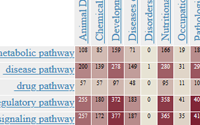Inbred Strains of Rats and their CharacteristicsINBRED STRAINS OF RATSUpdated April 9, 1998. Michael F.W. Festing For the committee on Genetic Nomenclature of the Rat: T.J. Gill III, T. Nomura, G.W. Butcher, E. Gunther, H.W. Kunz, G. Levan, K. Moriwaki, T. Natori, H. Katoh
The first listing of rat strains was by Billingham and Silvers (1959), with subsequent listings by Festing and Staats (1973) and Festing (1979a,b). This latest listing is based on that list plus several recent updates, including Greenhouse et al (1991). Particular attention has been paid to studies involving several strains, and where possible strains have been ranked on their characteristics with approximately the top quartile being classified as "high" and the bottom as "low". Thus, 'low litter size (10/12)' indicates that the strain in question ranked 10th. of 12 strains in which litter size was reported in a particular study. It must be emphasised that strain rankings may alter in different environmental conditions, so these should only be taken as a guide. The list contains 234 strains.
It is clear from the listings that there are many inbred strains of rat, but little is known about most of them. Many of them are likely to have characteristics of interest. More effort in characterising these strains would probably be cost-effective. Comparative studies involving several (six or more) strains, preferably including F344 and LEW as "standard" strains would be particularly valuable.
The following gene symbols have been used in the listings without further explanation:
Symbol Name A Agouti a Non-agouti H Non-hooded h Hooded hi Irish hooding (much more black than h) P Non-pink-eyed (ie, wild type) p Pink-eyed dilute.
INBRED STRAINS OF RATS Updated 9 Apr. 1998 Michael FW Festing MRC Toxicology Unit, Hodgkin Building, University of Leicester, UK |
|
|
 |
 |
 |
 |
RGD is funded by grant HL64541 from the National Heart, Lung, and Blood Institute on behalf of the NIH.














